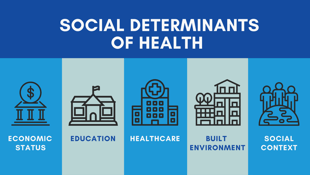How Social Determinants of Health Shape Outcomes in Value-Based Care
For the past ten years social determinants of Health (SDoH) have gained greater importance from health care organizations and legislators, and the...
.png)

The large majority of American land is rural, so it can often feel like a daunting task to define which populations are included when we say “rural America.” According to the U.S. Census Bureau, there are two forms of urban areas, urbanized areas (population of 50,000+) and urban clusters (population between 2,500-50,000). Any population, housing, or territory that does not fall into either of these categories is considered rural.
Rural Americans lead different lives than their urban counterparts, with a higher likelihood of living below the poverty line, lower median incomes, a higher percentage of seniors, higher acuity levels, lower health literacy, and lower life-expectancies. Despite comprising around 20% of the total U.S. population, rural areas are typically overlooked and underserved.
People who live rurally are more likely to die prematurely of all of the five leading causes of death: heart disease, cancer, injury, chronic lower respiratory disease, and stroke. Rural residents also embrace lifestyle habits that increase their likelihood of being obese and developing diabetes.
Transportation services are lacking in rural areas. Oftentimes hospitals are too far and therefore too expensive to travel to, travel delays can lead to missed appointments, and overall frustration with transportation infrastructure and health system locations can lead rural Americans to delay seeking the care they need.
People in rural America are experiencing rising behavioral health challenges. Rural residents are more likely to smoke more cigarettes, abuse alcohol and drugs, participate in risky behaviors, and die of a drug overdose. They’re also less likely to use protection measures, like seatbelts.
Rural healthcare is also facing a workforce shortage problem. The patient-to-primary care physician ratio in rural areas is 40 per 100,000 in rural areas while it is 53 per 100,000 in urban areas, negatively impacting care delivery as it becomes more difficult to find a provider and care seeking is delayed. Rural hospitals find it hard to recruit physicians due to the same conditions that are degrading the health of people living rurally, like poor housing and lower proximity to healthcare services.
Rural hospitals also aren’t financially stable. Over 126 rural hospitals have closed since 2010. The percentage of hospitals with negative operating margins is between 44% and 52%.
Earlier this month, the Center for Medicare & Medicaid Services (CMS) announced the creation of its new Community Health Access and Rural Transformation (CHART) Model. The goal of the CHART model is to assist rural communities in developing a more comprehensive healthcare system with increased quality and decreased cost through new seed funding and other payment structures, technical support, and regulatory flexibility for rural providers.
There are two tracks for participation in the CHART model—the Community Transformation Track and the Accountable Care Organization (ACO) Transformation Track.
With the Community Transformation Track, CMS plans to invest up to $75 million dollars in seed money in up to fifteen entities that represent rural communities to participate in the Community Transformation Track. This allows for care delivery reform through collaboration with community partners and other state agencies. Predictable capitated payments support current rural providers and entice new providers with a more stable revenue stream, and make care delivery financially viable and flexible.
In September, CMS will select the rural communities participating in the Community Transformation Track, with the participants announced in early 2021 and the model set to start in summer 2021.
The Accountable Care Organization Transformation Track offers an up-front investment. Providers participating in the ACO Transformation Track will enter into two-sided risk arrangements as part of the Medicare Shared Savings Program, and may use all waivers that are available in the MSSP program. Participants will receive advanced shared savings payments, which will vary based on the level of risk and the number of rural beneficiaries.
CMS plans to release a request for applications in Spring 2021 and will be selecting up to 20 ACOs to participate starting in early 2022.
.png?height=150&name=SpectraMedix%20-%20Stacked%20Logo%20(1).png)

For the past ten years social determinants of Health (SDoH) have gained greater importance from health care organizations and legislators, and the...

COVID-19 has reignited the conversation regarding social determinants of health (SDoH) as certain minority groups are at a greater risk for...